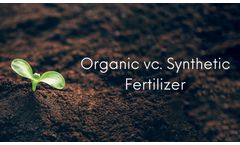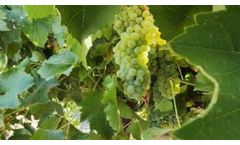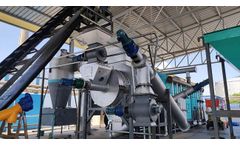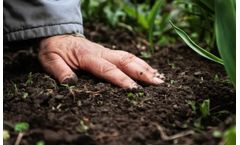Soil Microorganisms Articles & Analysis
89 articles found
Feeding your plants is a fundamental aspect of nurturing a thriving garden, whether you’re aiming for a bountiful harvest or flourishing blooms. However, the choice of fertilizer significantly impacts the health of your plants and the environment. There are two primary types of fertilizers – organic and synthetic. In this article, we’ll delve into the pros and cons of each, ...
During the 2023 growing season, Mr. Steven Deitz, a research consultant with Sawtooth Ag Research (Selma, CA) conducted a field study using a new ROS mineral oxychloride disinfectant, JC 9465, to control sour rot in mature (6 years old) wine grapes (cv. French Columbard) vineyard. The test site (vineyard) had a history of virus infections that showed symptomology late in the season when under ...
Biochar is a carbon-rich material produced through the pyrolysis of organic biomass under low oxygen conditions. Common feedstocks include agricultural waste, forestry residues, and even municipal organic waste. Its porous structure and chemical properties make it highly effective for soil improvement and environmental benefits. Agricultural practices in developing countries often face hurdles ...
Plants are firmly rooted in the soil, and their root system, along with its apoptosis, abscission, and secretions, serves as a vital source of nutrients and energy for microorganisms. ...
For generations, farmers have relied on chemical fertilizers to boost crop yields. However, these fertilizers come with a hidden cost: environmental damage. Here's where biochar steps in as a game-changer for sustainable agriculture.What is Biochar?Biochar is a charcoal-like substance created by heating organic materials like wood chips or crop residue in an oxygen-limited environment. This ...
They can improve soil fertility, promote the growth and reproduction of microorganisms in the soil, improve the agricultural productivity of soil and improve the environment for plant growth. ...
Its porous structure creates a habitat for beneficial soil microorganisms, contributing to soil health and fertility. Nutrient Retention: Biochar has a high cation exchange capacity (CEC), enabling it to retain nutrients such as nitrogen, phosphorus, and potassium in the soil. ...
Unlocking Data-Driven Insights for Sustainable and Efficient Farming For centuries, agriculture has relied on tradition and intuition, with farmers often relying on their experience and gut feeling to make decisions about their land. However, the 21st century has ushered in a new era in agriculture, one driven by data and innovation. At the forefront of this revolution are intelligent soil ...
Though it is the foundation of life, soil constitutes only a thin layer of material on the surface of our planet. It provides the necessary weathered minerals, organic materials, air, and water, which are the most precious resources for all living creatures. Plants find life in soil, as it provides a rooting medium and nutrient source for plants to grow. Through healthy plants, ...
The growth in human population has had an important impact on soil and the services and resources it can provide. The consequences of human activities on soil resources resulted in the loss of biodiversity, accelerated erosion, desertification, compaction, nutrient depletion, and loss of soil organic matter (SOM), which is primarily made up of carbon (58%). Considerable losses of soil carbon ...
In the realm of modern agriculture, where innovation is the driving force behind sustainable practices, biochar stands as a beacon of promise. Its transformative effects on soil enrichment, nutrient management, and climate resilience have earned it a hallowed place in the arsenal of forward-thinking farmers. Now, with the advent of technology, the biochar making machine takes center stage, ...
They go together like salt and pepper – they’re better together When you have a strong and varied crop rotation, it produces a greater diversity in the soil microbiome, which improves activity both above and below the surface. One of the most critical parts about a healthy crop rotation is bacteria – both good and bad – because when you change crops, you change pathogens. ...
The keratinase enzyme is extracted from a variety of microorganisms and has a wide range of applications in feed, leather, pharmaceuticals, food, and many other industrial as well as major ecological applications. ...
In the 1970s, a study found that some soil microorganisms have a degrading effect on pesticides. These microorganisms secrete an enzyme that hydrolyzes phosphate bonds, that is, organophosphorus pesticide-degrading enzymes. ...
Inulinase is a kind of hydrolase that can hydrolyze β-2, l-d-fructan glycosidic bond. Inulinase-secreting microorganisms are widely distributed in nature, including various microorganisms in soil, water, and animal digestive tracts. ...
Earth Innovations is a new series from Sound Agriculture that covers the up-and-coming techniques growers are deploying to keep their yields high and their land healthy for generations to come. In each blog post, we break down the benefits and challenges of incorporating new practices, using real growers’ experiences and the Sound Agronomy Team’s expertise. Cover crops are ...
As I "dig" deeper into the soil microbial world I am amazed how much we understand but few utilize what we do know. The word is getting out that if we let the soil microbes thrive and multiply by feeding our soil degradable plant and organic material the microbes will give our plants and crops back the nutrients they need. We are now finding that by adding fertilizers directly in the inorganic ...
Introduction The product used for this application is BIOLOGIX SALT BINDER. BIOLOGIX SALT BINDER is a proprietary humidified soil extract with the multiple essential soil microbes included in the formulation. The product works by providing an organic substructure with an extremely high ion exchange capacity that the Na++ and CI- ions can bind and be charged neutralized (via an ionic bond). The ...
According to Dr. Surendra Dara of the University of California Cooperative Extension, 90-95% of strawberry growers in California use predatory mites to manage two-spotted spider mites. But how did this pest control method get so widely adopted? What can growers of other crops learn from this experience? To discuss this topic, I reached out to Lane Stoeckle, a certified crop advisor and pest ...
Sales agronomists Zach Carlson and Sarah Taylor discuss the relationship between soil microbes and soil health, and how this relationship impacts the bioavailability of the nutrients plants need. The presence of soil microbes makes a functional soil, holding and releasing nutrients that plants require. Proper levels of these microbes reduces plant stress and increases the bioavailability ...













